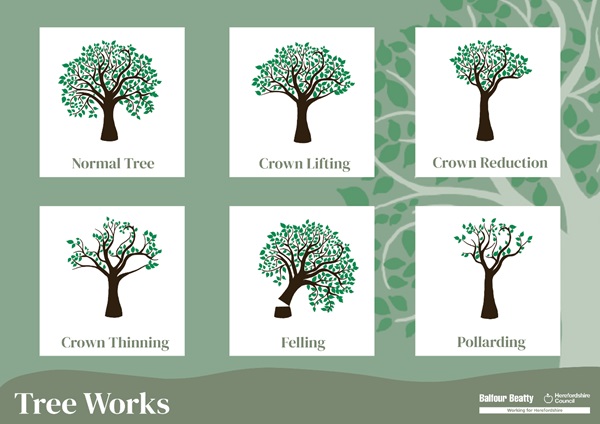Tree works
The council's responsibility
Herefordshire Council are responsible for trees on land owned by the council. This includes trees on our highways which are maintained by Balfour Beatty Living Places through the Public Realm Service.
Council-maintained trees are pruned or removed when they are:
- Diseased, damaged or dying
- Dangerous, because the tree or part of the tree has fallen or is at risk of falling - Report a dangerous tree on public land
- Getting in the way of vehicles or pedestrians, or causing safety issues by blocking street lighting, road signs or traffic lights - Report vegetation overhanging the public highway
We also carry out pruning when it's needed to keep trees healthy.
Types of tree works

- Crown lifting is the removal of lower branches to lift the height of the crown's base. It's carried out to increase the clearance between the ground and the lower branches. It's also used to reduce weight from a tree and allow more light to pass through the branches.
- Crown reduction is one of the most common pruning techniques arborists use to control the size of the tree while maintaining the structure or shape of its crown. Arborists focus on limbs on the uppermost portion of the tree canopy, cutting them shorter to decrease the tree height.
- Crown thinning involves the selective removal of inner branches evenly throughout a tree's crown. This is an effective method of allowing light to travel through the crown and allows air to circulate more effectively throughout the canopy without altering the tree's natural shape.
- Pollarding is a method of pruning, often used in the management of street trees, where the upper branches of a tree are removed to limit their height. This can help prevent damage to overhead wires, stops trees from obscuring streetlights and can also reduce root growth that could damage pavements and other surfaces. It also reduces debris from twigs and dead leaves. While it may look extreme, pollarding promotes healthy regrowth and can prolong the life of the tree.
Bird nesting
We undertake surveys before any works are carried out on our trees to ensure we do not disturb any nesting birds or other protected wildlife.
High or overhanging vegetation
Where an overhanging hedge interferes with safe use of a public path or highway, it is the landowner's responsibility to cut it back. If the council agrees that the hedge or tree is causing a problem we can insist that the owner cuts it back.
For more information see our overhanging trees and hedges page.
Trees on private land
The council is not responsible for trees on private land.
Property/landowners are responsible for maintaining trees on their property and making sure they are safe.
Before carrying out any work on a tree in your own garden, check whether the tree is protected by a Tree Preservation Order or is in a conservation area.
You can find a list of qualified tree surgeons on the Arboriculture Association's website.
In extreme circumstances, and when all other avenues have been explored, we can take action to ensure that dangerous trees on private land are made safe.
